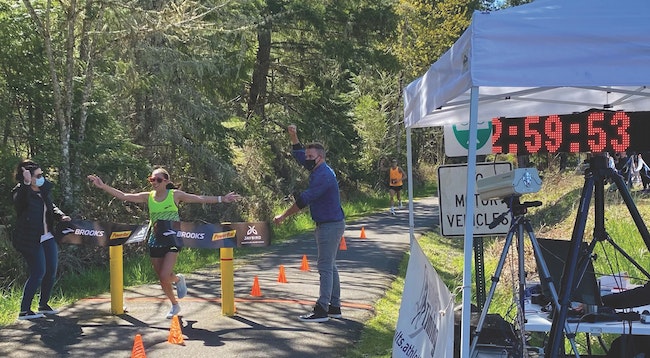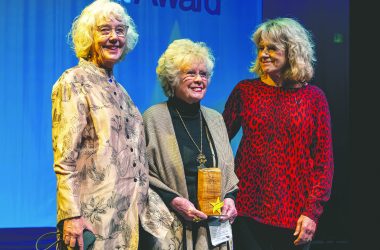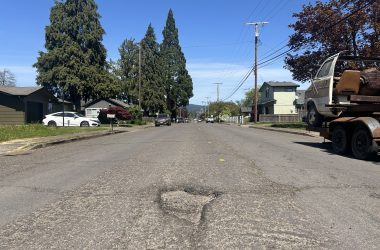 ALICE DOYLE/PHOTO
ALICE DOYLE/PHOTO
Des Linden breaks the tape in record time for a women’s 50K ultra-marathon on Tuesday, April 13, in Cottage Grove.
When you hear the word “marathon” it usually means something epic or vast in proportion, such as “Last night I did a marathon study session to try to get ready to pass that @#$&! exam.”
If you are athletically inclined the 26.2-mile footrace, a marathon, probably is what comes to mind. The name of the race comes from the Greek city Marathon, about 25 miles from Athens.
Through mist-clouded legend trickles down the story of the brave soldier Pheidippides. After a hard-fought battle and the invading Persians had been defeated at Marathon, he saw a Persian ship peel off and head toward Athens. Pheidippides feared the ship would land in Athens to declare the Persians had won and attempt to take over the city-state. He began running to the capitol, shedding weapons, armor, and clothes as he went. He made a dramatic entrance, naked, winded, with just enough life left in him to cry “We have won,” before collapsing and dying on the spot.
That battle definitely happened in 490 B.C. but there is not much historical proof for Pheidippides heroics. But like much in life, a good story has legs so the legend was passed down, embellished and enshrined in statues, paintings and even in the poem “Pheidippides’’ by Robert Browning in 1879.
When the modern Olympic Games were being planned, after a hiatus of 1505 years, organizers wanted to insert a popularizing event that evoked the glory of ancient Greece. The idea of a race to represent the fabled run of Pheidippides was suggested and immediately seized upon by modern Olympics founder Pierre de Couberitn. Naturally all of Greece was enthusiastic, which mattered since the first Games in 1896 were held in Athens.
 DANA MERRYDAY/CHRONICLE PHOTOCharlie Lawrence helped Des Linden pace herself through the record run.
DANA MERRYDAY/CHRONICLE PHOTOCharlie Lawrence helped Des Linden pace herself through the record run.
That first marathon was set at 40 kilometers (about the distance between Marathon and Athens, 24.85 miles) and the distance bounced around at every Olympics depending on the host country, until 26.22 miles became the world standard in 1924.
Like most Olympics sports, the marathon was exclusively male until the women were added at the 1984 Summer Olympics in Los Angeles.
The oldest annual marathon race is the Boston Marathon. Although it had to be cancelled in 2020 due to Covid, it had up until then, run every year since its 1897 founding. The Boston race started as a local race inspired by the success of the Olympic event the year before in Athens, but grew to attract world-famous runners.
The race is scheduled for Oct. 11, 2021, which would be the 125th Boston Marathon.
Up until after the 1967 race the Boston race rule book made no mention of gender or the Amateur Athletic Union (AAU) for that matter. Roberta “Bobbi” Gibb attempted to register for the 1966 Boston Marathon, but was refused in a letter claiming women to be “physiologically incapable” of running 26 miles. She ran anyway, unofficially, and came in with a time better than two-thirds of the race participants.
The next year, 1967, Katherine Switzer registered with her official AAU number, required fitness certificate, and signed her name with her usual K.V. Switzer. She was the first registered woman to run the Boston Marathon. Despite some ugly attempts from race officials to stop her during the race, she completed the marathon. The next year both the Boston Marathon and the AAU changed their rules to prevent women from competing in races against men.
That changed in 1972 when the Boston Marathon became the first race to officially register women. Three years later they made history again and became the first to admit participants in wheelchairs.
The 2018 Boston Marathon was held in cold, rainy, and windy conditions, and Desiree “Des” Linden became the first American to win the Boston Marathon’s women’s race since 1985. It was an epic victory wrested from nasty conditions and wowing commentators by her sportsmanship. Linden had slowed down her race to wait for teammate Shalane Flanagan, who had to make a quick porta-potty stop. They had been talking during the race and the strong headwinds and cold conditions had lowered Linden’s expectations of even finishing the race so she told Flanagan she would try to do what she could to get her back in the race. Linden, having dropped back, connected with Flanagan and they took on the task of catching up to the pack. At some point, Des’ drive kicked in and she pulled ahead and went on to win. Shivering in the cold with the laurel wreath on her head and wrapped in a towel, Linden said through chattering teeth, “It’s supposed to be hard!” She was probably thinking, among other things, maybe not this hard.
That victory must have been sweet. Linden had come in second, missing first place by only two seconds in the 2011 Boston Marathon. The 2018 win topped a number of very respectful finishes in races such as the Chicago, New York City, and Boston marathons in the years preceding and following her victory. She also qualified for the 2012 Olympics in the marathon. During the Summer Olympics in London, Linden was unable to finish the race due to a stress fracture of the femur.
In 2016 she placed second in the Olympic trials and went on to place seventh in the Women’s Olympic Games marathon race in Los Angeles. For the 2020 Olympic trials Linden came in fourth place, only 11 seconds from claiming a slot on the team. She is an alternate should any of the other three members drop out, ready to serve but not really counting on it. She was planning on competing in the 2020 Boston Marathon when Covid decided that she wouldn’t. It was announced in May that the 124th running of the marathon, which had been postponed from April until September, would be canceled.
Like many other areas in life the coronavirus has taken away many opportunities we take for granted. For a professional runner to be sponsored and run for your living, it was a sudden case of what do I do now? Sure they can run, but without events being able to take place there was a lot of doubt thrown into Linden’s life. Since all events she planned on competing in had been canceled she and her runner husband started looking for ways to make running fun and interesting during their forced time off. One of the things they came up with was the “Destober Challenge,” held in October, naturally. Leading up to the month-long event the pair did 70-mile training weeks, then it was running the number of miles corresponding to each calendar date. By the last week they had racked up 196 miles.
Linden started running seriously at age 10. “I was good at it right from the start. In middle school I got a lot of acknowledgement and encouragement from my parents. I wanted to see if I could get better at it.” She did, being a finalist at the CIF California State Track meet all four years of high school. Linden went to Arizona State on a track scholarship where she was a two-time All-American in track and cross country. After college she has been a full-time professional runner.
On April 13, Linden, her team, and several world-class runners slipped into town for a little run up on the bike path. Covid had a hand in making this a quiet event. There were real concerns, despite it being an outdoor race, that forced the organizers to keep things discreet. There were no public announcements as to when or where the run would be held, but word had leaked out in running circles that marathoner Linden was setting her sights on the ultra-marathon 50 kilometers (31.1 miles). It was a new event for her. She had planned on participating in the South African Two Oceans Marathon, an ultra 56k event, in April 2021. When the cancellation was announced in February, it got the wheels turning for Linden’s team. Since she had already trained, why not run for the world’s record? At the time the 50K record was held by Alyson Dixon at 3:07.20.
Her agent, Josh Cox, also a runner and American 50K record holder, reached out to Ian Dobson, race director of the Eugene Marathon (which was held last weekend in a virtual format). Dobson and his team provided invaluable assistance in setting up the course, providing physical support, and local knowledge.
In responding to my question as to why Linden’s team selected the Cottage Grove area, Dobson replied, “There are a few reasons the Row River Trail was selected for this event. Last fall we used the trail for a couple of small half-marathons similar to this event; they were micro-events that were designed to be ‘Covid-proof’ in the sense that they were done with just the bare minimum of people involved and we wanted to do them in a location that was unlikely to be busy. Those events were successful, word got around in elite running circles that the Row River Trail was a great place to run fast, and early this year Des Linden’s team reached out to see if the Eugene Marathon would be interested in helping to facilitate her record attempt. In the short term, Covid has changed so many things about road racing, and the Row River Trail just happens to be really well-suited for small, fast events. The trail is flat, scenic, relatively quiet, and has very few road crossings.”
Besides Linden, other elite runners who showed up to run were Chirine Njeim of Beirut, Lebanon, Adriana Pirtea Nelson – Romanian-American, and Nicholas Thompson, The Atlantic CEO. All of the runners from Linden on down, were complimentary of the natural beauty of the area, the great set-up of the course, delightful weather and all around perfectness of the course for their purposes.
Thompson in particular had an interesting result for his race. He is one of the few runners who has actually improved with age. Unlike wine, competitive runners are likely to not age well. Thompson, who was inspired to run by his dad’s example, had a lackluster career in high school and college, but kept at it all his life and gradually improved as he moved through editor jobs, family life, and cancer surgeries. He really made progress when he got his first serious scientific coaching from Steve Finley. In addition to Linden’s world record, Thompson added to his own by establishing the American’s men’s 45-49 years old 50k record of 3:04.36.
When Linden sprinted across the finish line she was greeted by a small group of spectators and media representatives. Covid had dictated the need for secrecy and no publicity. But Linden’s team was grateful that word had leaked out a bit and some people were there to cheer her victory over the clock. This reporter had been tipped off by a dog walker who discovered the international survey team when they were measuring and marking the bike path to accommodate the run. When she asked what they were doing, they spilled the beans about the race and so word got passed on to me.
The excitement began to build as Linden was heading toward the finish line at Bake Stewart Park. It was looking like, barring the sky falling or a last-minute cramp, she was on track for a record time. The ribbon was stretched across the finish line, and as Linden came into view shouts of encouragement rose from all present. By bursting through the finish tape at 2:59.54 she claimed the new women’s 50K world record.
If one thought it was easy to run 31.1 miles in less than three hours, the 37-year-old’s body let us know that was not the case. Her first drinks of water at the end of race didn’t stay down long and Linden had to bend over in the tall grass as her body rejected the life-giving fluid as a reaction to the stress she had just put it through.
It was a new experience to be rubbing elbows with elite runners and their entourage right here on my beat. I got to talk with the folks who ran with Linden as “pacers.” These experienced runners helped keep her on track to beat the record. Charlie Lawrence ran the entire route with her and helped ensure that the pace was even, averaging 5:47 per mile. “Des ran great, with a sub three-hour run that destroyed the world record,” he said, sounding as excited as if he had set the record himself.
After a brief news conference for the assembled media and the ceremonial sipping of champagne from running shoes, Linden changed into warmer clothes. Asking if she had any words for The Chronicle’s readers, she said, “This is such a beautiful area and quite a fun place to run. The views over the lake are so beautiful and being in the trees was inspiring. I am also pretty spent!”
After congratulating her, I took my leave and left feeling as if I had witnessed something not only unique but marveled at how it was yet another of those “only-in-Cottage-Grove” experiences brought about by someone curious about why people would be spray-painting marks on the bike trail and inquiring into it.
Happy and proud to have been a part of running history, right up Dorena way!
Email:








